The White Oak, The Pound, Cookham, Berkshire, SL6 9QE www. thewhiteoak.co.uk
 Stepping from the golden-hued dining room into the professional kitchen of The White Oak is as intimidating as it is intriguing. The crew is prepping for lunch and I don’t want to be in the way, to slow the pace or, worse, show my ignorance. Nor do I want to get caught in the crossfire of a tempestuous kitchen nightmare so I’m relieved to find the atmosphere is of calm, contemplative, careful collaboration.
Stepping from the golden-hued dining room into the professional kitchen of The White Oak is as intimidating as it is intriguing. The crew is prepping for lunch and I don’t want to be in the way, to slow the pace or, worse, show my ignorance. Nor do I want to get caught in the crossfire of a tempestuous kitchen nightmare so I’m relieved to find the atmosphere is of calm, contemplative, careful collaboration.
I’m here for a steak masterclass with the pub’s well-regarded chef, Clive Dixon. Head chef at the age of 23 – at Lords of the Manor when it was awarded its Michelin Star – Clive has worked with Pierre Koffman; run The Hinds Head for Heston Blumenthal; and was sous chef at Clivedon 20 years ago. He’s been at The White Oak since November 2011, not only as head chef but also as a partner in the business. He made changes immediately, reducing the number of covers to make the pub more relaxed – a place to lounge around (stylishly, though … this is Cookham) – and to control the kitchen. He introduced a £10 two-course lunch (a stroke of genius; as I left, the restaurant was full) and makes changes to the main menus every day, to keep diners interested.
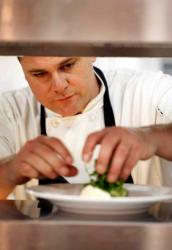 As with its newer sibling restaurant, The Three Oaks in Gerrards Cross, steak is a big seller and, for Clive, it’s always “only the best qualityâ€Â. He had that while at Lords of the Manor, using a quality assurance scheme butcher, but in his next role he was obliged to use a mass-catering butcher. “I learned the hard way,†he said looking glum. Their attitude was “what are you using and how much are you paying?†which is the wrong emphasis. When the phone rang and Peter Allen, of specialist chef’s butcher Aubrey Allen, said “I’m embarrassed not to be serving you†Clive was released. He wanted to use cheeks and tails, not dull catering cuts, and raise standards.
As with its newer sibling restaurant, The Three Oaks in Gerrards Cross, steak is a big seller and, for Clive, it’s always “only the best qualityâ€Â. He had that while at Lords of the Manor, using a quality assurance scheme butcher, but in his next role he was obliged to use a mass-catering butcher. “I learned the hard way,†he said looking glum. Their attitude was “what are you using and how much are you paying?†which is the wrong emphasis. When the phone rang and Peter Allen, of specialist chef’s butcher Aubrey Allen, said “I’m embarrassed not to be serving you†Clive was released. He wanted to use cheeks and tails, not dull catering cuts, and raise standards.
Passion and scandal
Peter took him to his butchery unit in Coventry and talked about grading. They went to Scotland to meet farmers and, more importantly, see the cows. Clive now goes every year, because “you never stop learningâ€Â. And learn I did.
He uses Scottish beef because “the farmers’ passion is incredible; it’s what’s best for the cow. Yes, you have to pay more but you see the cows and know the farmer is doing everything the very best way. It’s all done with an eye on the meat, there is no cutting corners. It takes two to two-and-a-half years to rear an Aberdeen Angus cow to produce a good steak. Elsewhere, many cows are reared for 18 months; they’re not ready.â€Â
“It’s one of the scandals of our time,†interjects Peter. “Most beef in supermarkets isn’t beef. It is a bi-product of the dairy industry. To produce milk, cows need to produce a calf every year; they are too young to make good beef. Beef is meat that is beyond adolescence, from an animal with full adult teeth.†His beef comes from bullocks (castrated males) which produce a much more tender and flavourful meat.
For Clive, the passion must not stop at the field gate. The abattoir is important. So, too, is the grading of the beef. He only buys E and U grades with the right fat content (in the EUROP classification of beef quality, E is excellent; U very good; R good; O fair; P: poor – which makes you wonder who buys the O and the P and how often we’ve eaten it without knowing). He always buys it on the carcase.
Age and ageing
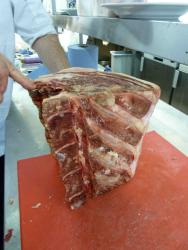 Beef on the bone – on the carcase – and kept in the correct environment by a good butcher, matures; its flavour develops. This is known as dry-aged. In Clive’s view, the optimum dry-ageing time for steak is 21 days; for burger beef it’s seven days.
Beef on the bone – on the carcase – and kept in the correct environment by a good butcher, matures; its flavour develops. This is known as dry-aged. In Clive’s view, the optimum dry-ageing time for steak is 21 days; for burger beef it’s seven days.
At this point I learned something so obvious I felt stupid not having thought it through. This flavour and quality improving ageing process can’t take place when the meat is off the bone. Off the carcase, it isn’t maturing; it’s deteriorating. Even in the bag – vacuum-packed – it is, as Peter puts it, going downhill, more so after about 14 days. This is known as wet-aged – a euphemism I’m not entirely happy with. As for supermarket packets, they contain gases that prolong shelf life – another less than delicious eye-opening fact. No wonder, as Clive pointed out, it’s hard to make a soggy, floppy plastic-packed steak caramelise, or to stand it up in a pan when cooking the fatty edge.
This deterioration doesn’t only apply to beef and, with a further twist of a sharp, professional butcher’s knife, they add that the more surfaces there are, the greater it will be. Bought a package of sliced cheese or smoked salmon? It will go off more rapidly than a chunk or side. Peter recommends buying smoked salmon from Formans. Sliced to order and delivered vacuum-packed overnight, it’s as fresh as you can get it without making it yourself. The White Oak smokes its own salmon – obviously.
Back to steak and Peter is wielding his pointed knife (both he and Clive use Victorinox) and his charming but on-the-point tongue. The chains – he mentions Café Rouge and Côte – are food businesses run solely for money. “In America, menus must state the grade of the steaks; you know what you are getting. You don’t know that hereâ€Â, he says. He challenges us to ask restaurants what their sourcing policies are. Most won’t know what they are getting, a sure sign it’s not something to be proud of. And if the beef comes from Argentina, it can’t be dry-aged. The provenance might be good (with heart-warming descriptions of animals running wild on pampas grass) but it’s made the journey in vacuum-packed packages.
Cheap is not worth it
Boning meat is done for efficiency; you get more on the lorry (another light bulb pings on). Boning it; cutting it up; blast-chilling it (which shortens the meat’s fibres, making it tough); vacuum-bagging it; then days to deliver it and put it on the shelf … Peter couldn’t be clearer; only dry-aged beef is worth paying for. “It’s what you buy, not how you cook it. You can cook a cheap steak really well – but it still won’t be worth eating,†he says. I smile ruefully at the memory of cutting this price corner, doing all the right things in the kitchen, but being overwhelmingly disappointed. “Without quality, we’re all doomed,†he says.
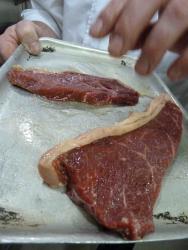 He gets to work on an enormous piece of rump. There are 28 muscles in it, running in different directions and separated by connective tissue and gristle. He cuts it up using the French cutting method, first separating the rump cap from the rump, manipulating his knife to remove the sinew (it’s what makes an English cut steak so very tough to chew and “gives rump a bad name†he says). Off comes the spider steak. Clive drizzles them with olive oil, sprinkling on salt, then it’s flip, flip, flip to ensure the seasoning is even. A heavy skillet reaches smoking point and it’s in; it’s over; it’s out. And it’s dry, dull and endlessly chewy. Peter’s played a clever trick; he’s cut the rump cap the wrong way making it inedible. They watch as I struggle, not only with what’s in my mouth but also with what I might say with it. Thankfully, they counter my embarrassment by speaking my mind for me.
He gets to work on an enormous piece of rump. There are 28 muscles in it, running in different directions and separated by connective tissue and gristle. He cuts it up using the French cutting method, first separating the rump cap from the rump, manipulating his knife to remove the sinew (it’s what makes an English cut steak so very tough to chew and “gives rump a bad name†he says). Off comes the spider steak. Clive drizzles them with olive oil, sprinkling on salt, then it’s flip, flip, flip to ensure the seasoning is even. A heavy skillet reaches smoking point and it’s in; it’s over; it’s out. And it’s dry, dull and endlessly chewy. Peter’s played a clever trick; he’s cut the rump cap the wrong way making it inedible. They watch as I struggle, not only with what’s in my mouth but also with what I might say with it. Thankfully, they counter my embarrassment by speaking my mind for me.
The next taster – of rump cap cut properly – is an explosion of flavour and juiciness. Such a difference, from the angle of a knife. The spider steak is incredibly tender, almost soft. The fourth steak, a single muscle known as the “lady’s steak”, is full of dark flavour. I’m amazed at how different each cut tastes – and at the skills of a master butcher.
When is steak like John West salmon?
Peter continues to remove fat and sinew, building up a mound of wastage. “It’s like the John West advert … ‘It’s what we don’t put in that makes our salmon the best’â€Â, he recounts. Thirty-four per cent of the rump is discarded so it’s important to make the economical most of the rest.
A gorgeous rib of beef appears beside me; Peter points out the numerous textures visible. Off comes the rib eye. Then the rib edge – which includes a bit of bone. More trimming; every speck of gristle and fat is removed. An impossible-to-sell-as-it-is layer of beef lies in front of me. “You’ll never find this at a butcher,†I’m told. Peter rolls it up with a leek, a carrot, a stick of celery, some herbs and it’s become eminently presentable, if not how Clive would do it. Clive reveals that Peter taught him how to get 50 per cent more from a piece of beef.
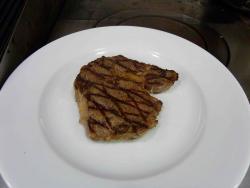 Clive’s cooked the rib eye. Flavourful and easy to chew, part of it is as soft as butter. It’s basted in butter, too – the best chefs cook a steak this way, basting, basting, basting, turning, basting, basting, basting to bring out its flavour. He’s served them all just as I like them – very rare.
Clive’s cooked the rib eye. Flavourful and easy to chew, part of it is as soft as butter. It’s basted in butter, too – the best chefs cook a steak this way, basting, basting, basting, turning, basting, basting, basting to bring out its flavour. He’s served them all just as I like them – very rare.
Is gristle ever good?
We are on to the blade steak, noted for the large spear of solid gristle running through it. The blade feels tough, rubbery, bouncy, unpleasant; it’s grey and stomach-churningly unappetising. It’s that bit you can’t chew, don’t want to swallow, is difficult to extract from your mouth elegantly, and embarrasses you from the side of your plate. Surely, it’s always inedible?
Clive slides a plate towards me. A dark chunk of beef glistens as it sits on the creamiest mash, some buttery greens and a silky gravy. He hands me a flattish spoon. The beef falls apart, it’s soft but textured, moist and packed with beefy meatiness. The sweetness of the greens, the simplicity of the mash, the intensity of the gravy, the richness of slowly braised steak – it’s hearty and moreish. The blade has softened, meltingly, adding an extra layer of flavour.
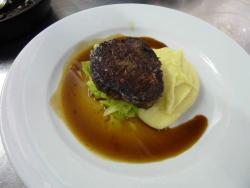 It’s not a short cut, or even a cheap cut given the attention paid to its cooking and presentation, and it’s as satisfying as a big, juicy hunk of rare steak. It’s not just sellable; it’s what Clive recommends when a diner asks for a steak well done.
It’s not a short cut, or even a cheap cut given the attention paid to its cooking and presentation, and it’s as satisfying as a big, juicy hunk of rare steak. It’s not just sellable; it’s what Clive recommends when a diner asks for a steak well done.
Steak should be rare and rested. If that’s not how you like yours, don’t ask the chef to ruin a top quality cut; eat something else. If you are at The White Oak, you know what to do. Ask for the steak you can eat with a spoon.
Tips from Clive Dixon and Peter Allen
Age of the beef: Sixty days is too long – and unnecessary. After 28 days, perhaps a few more than that, it starts to go downhill. If you buy 21 or 28 day aged beef, remember that you can’t get it to the table on the 21st or 28th day; it might be in the fridge for a couple of days.
Beef: Hereford and Aberdeen Angus are the best, here in the UK.
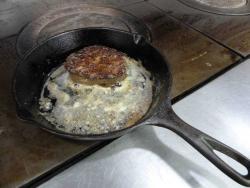 Cooking a steak: It comes with practice, building an instinct for when it’s perfectly cooked. Start by using a probe but aim to abandon it. Cooking is a sensory experience; learn to be led by your senses; don’t leave it to a machine to tell you. Baste liberally with butter. Always let it rest, keeping it warm.
Cooking a steak: It comes with practice, building an instinct for when it’s perfectly cooked. Start by using a probe but aim to abandon it. Cooking is a sensory experience; learn to be led by your senses; don’t leave it to a machine to tell you. Baste liberally with butter. Always let it rest, keeping it warm.
Gravy: Its body and volume matter. Use home-made stock – and a good quality flour.
Lunch menus: You should never feel you’ve been offered “only the lunch menu” as if it were of a lower standard than the main menu. Even if it includes cheaper cuts, it should be exciting, demonstrating that a lot of effort has gone in to each dish. I’m reminded of those voucher deals at well-known restaurants – and how disappointed I’ve been, leaving vowing never to eat there again. Getting us in on the cheap is the wrong short cut. If I’d eaten the White Oak’s £10 two course/£15 three course lunch menu the day I was there I’d have chosen caulifower soup with Parisienne gnocchi; pork collar with cockles and garlic roast potatoes; and crème brûlée. Effortfull and much more than good value.
Mash: Use Ratte potatoes; they are much smoother, creamy. Steam them till they “go to the touch” or cook them sous vide so there is no additional water content. Add warm milk; use lots of butter.
Olive oil: Must be cold-pressed; most are not from a single source. Olive oil from Tuscany is amazingly flavoured.
Roast potatoes: Cook them completely first; they need to be soft on the outside but still holding together.
Salt: Clive uses sea salt from the Camargue; he keeps it in the fridge.
Seasoning: Do this stage by stage, tasting all the time. You shouldn’t have to add salt at the end. For a soup, for example, add it as you sweat the onion; then when you add each ingredient. The stock must be correctly seasoned, too.
Wet-aged beef: How can you tell whether you are eating wet-aged or dry-aged beef? Flavour. Wet-aged beef might, through clever cooking, give you an initial hit of caramelisation; it might even be silkily tender. But there will be no explosion of flavour, no aftertaste – it dies in the mouth. Sadly, I’ve definitely experienced that …
